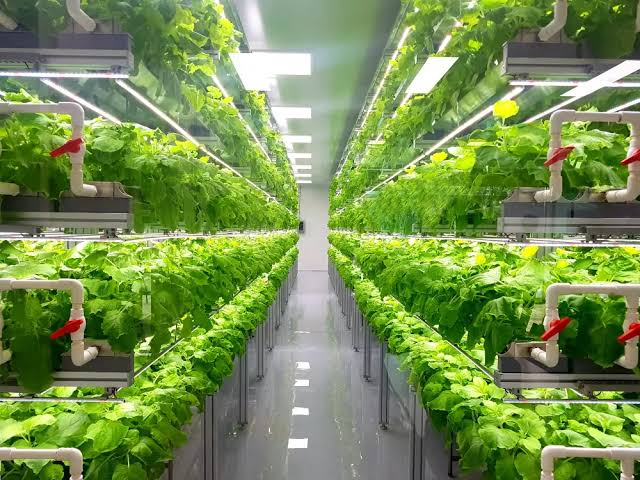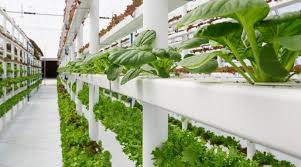Vertical farming is a modern way of growing crops that doesn’t rely on traditional horizontal fields. Instead, it goes up, stacking layers of crops vertically. Imagine a building where plants grow on shelves, one on top of the other, reaching towards the sky.
One of the main reasons people are excited about vertical farming is its potential to save space. In cities where land is scarce, this type of farming allows us to use buildings for growing food. Think about it like a garden in the air.
But it’s not just about saving space. Vertical farming can also use less water than traditional farming because it often involves hydroponics. That means plants grow without soil, getting the nutrients they need from a water solution. It’s like the plants are getting a special drink with all the vitamins they crave.
Another cool thing about vertical farming is that it can happen all year round. Traditional farming depends on the seasons, but with carefully controlled environments in vertical farms, we can have fresh veggies even in the middle of winter.
Now, let’s talk about the environment. Vertical farming can be more eco-friendly. By growing food closer to where people live, it reduces the need to transport it over long distances. Less travel for our veggies means fewer carbon emissions, which is a good thing for our planet.
But like all things, vertical farming has its challenges too. The special lights needed for the plants to grow indoors use electricity, and finding the right balance of nutrients for the water solution can be tricky. Plus, setting up a vertical farm requires a bit of an investment.
However, vertical farming is like a high-rise garden that could change the way we get our veggies. It’s a space-saving, water-efficient, and eco-friendly way to grow food. While it’s still finding its footing, the idea of having farms in the sky is pretty exciting, don’t you think?
Read Also: Pig Behaviour and the Effect of Climate
What are the Advantages of Vertical Farming?

Vertical farming comes with several advantages which are:
1. Space Efficiency: Vertical farming maximizes land use by growing crops in stacked layers. This is particularly beneficial in urban areas where space is limited. It allows for more food production in smaller areas.
2. Year-Round Crop Production: Controlled indoor environments in vertical farms enable year-round crop production. Regardless of the external weather conditions, these farms can provide a consistent and reliable supply of fresh produce.
3. Water Conservation: Many vertical farms use hydroponic or aeroponic systems, reducing the need for soil. This not only saves space but also results in more efficient water usage compared to traditional soil-based farming.
4. Reduced Transportation: Vertical farms located in or near urban centers can significantly reduce the distance food needs to travel to reach consumers. This minimizes the environmental impact associated with long-distance transportation, such as fuel consumption and carbon emissions.
5. Lower Dependency on Weather: Traditional farming is susceptible to the whims of weather, which can impact crop yields. Vertical farming, being an indoor process, is less affected by external weather conditions, providing a more stable and predictable food supply.
6. Crop Protection: Enclosed environments in vertical farms offer protection against pests and diseases. This reduces the need for pesticides, making the farming process more environmentally friendly and potentially resulting in healthier produce.
7. Optimized Resource Use: Vertical farms can carefully control factors such as light, temperature, and nutrients. This optimization leads to more efficient resource use, minimizing waste and ensuring that plants receive precisely what they need for optimal growth.
8. Job Creation in Urban Areas: Establishing vertical farms in urban areas can create jobs in a different sector of agriculture. This decentralization of farming can contribute to local economic development.
9. Adaptability to Various Locations: Vertical farming is not limited to specific climates or geographical locations. It can be implemented in various regions, including those with harsh weather conditions or limited arable land.
10. Innovation and Technology Integration: Vertical farming often involves cutting-edge technologies such as automated systems, artificial intelligence, and data analytics. This integration of technology fosters innovation in agriculture, paving the way for more sustainable and efficient food production.
In addition, vertical farming presents a range of advantages that address challenges faced by traditional farming, making it a promising solution for sustainable and resilient agriculture in the future.
Read Also: Main Principles of Pig Production for Maximum Production
Techniques Used in Vertical Farming

Several techniques are employed in vertical farming to optimize the growth of crops in a controlled indoor environment. Here are some key techniques:
1. Hydroponics: Hydroponic systems eliminate the need for soil, and instead, plants are grown in nutrient-rich water solutions. This method allows for precise control over the nutrients plants receive, promoting efficient growth.
2. Aeroponics: Similar to hydroponics, aeroponics involves growing plants without soil. However, in aeroponic systems, plants receive nutrients through a mist or air, promoting even greater oxygenation and nutrient absorption.
3. Vertical Stacking: The core concept of vertical farming involves stacking layers of crops vertically. This can be achieved through shelves, racks, or towers, maximizing the use of vertical space and allowing for a higher density of plants.
4. LED Grow Lights: Artificial lighting, especially using LED (Light Emitting Diode) technology, is crucial in vertical farming. LED grow lights provide specific wavelengths of light that cater to the needs of plants at different stages of growth, promoting photosynthesis and overall health.
5. Climate Control: Maintaining optimal temperature, humidity, and airflow within the indoor environment is crucial. This control allows for year-round cultivation and ensures that crops are not subjected to extreme weather conditions.
6. Controlled Environment Agriculture (CEA): CEA involves tightly controlling environmental factors such as light, temperature, humidity, and carbon dioxide levels. This precision enables the creation of an ideal environment for plant growth.
7. IoT and Automation: Internet of Things (IoT) devices and automation technologies play a significant role in vertical farming. Sensors monitor conditions, and automated systems adjust variables like lighting and irrigation in real-time, optimizing resource usage.
8. Recirculating Water Systems: Water conservation is a priority in vertical farming. Recirculating water systems collect and filter water, allowing it to be reused within the system. This reduces water wastage and promotes sustainability.
9. Nutrient Film Technique (NFT): NFT is a hydroponic technique where a thin film of nutrient-rich water flows over the roots of plants. This ensures a continuous supply of nutrients and oxygen to the plants, promoting efficient nutrient uptake.
10. Biological Pest Control: Instead of relying on pesticides, vertical farms often employ biological pest control methods. This includes introducing beneficial insects that prey on pests, maintaining a natural balance within the controlled environment.
11. Modular Farming Systems: Vertical farming systems are often modular, allowing for flexibility in design and scalability. This modularity facilitates easy expansion or modification of the farm layout based on specific needs.
These techniques, when combined, create a sophisticated and efficient system for growing crops in vertical farms. The integration of technology and careful management of environmental factors contribute to the success of vertical farming as a sustainable and innovative approach to agriculture.
Read Also: How to Make Money using Sa Recycling Company

